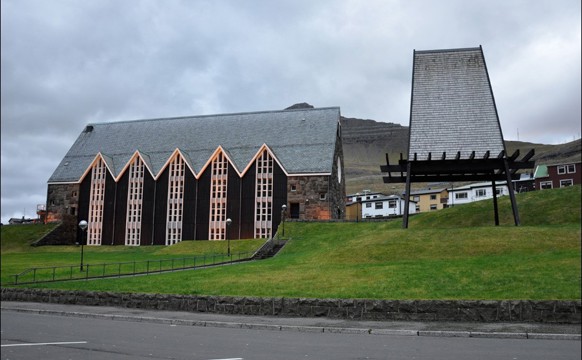In English

About the Church of the Faroe Islands
The Faroese national evangelical church is traditionally referred to as the Church of the Faroe Islands.
The people of the Faroe Islands accepted Christianity around the year 1000. According to the saga of the Faroe Islands, Sigmundur Brestisson built a church on the island of Skúvoy, and it is possible that chieftains and peasants built their own churches in their villages. It is, however, unlikely that any public church system was implemented until after 1100.
Shortly after 1000, an episcopal residence was established in Kirkjubø subject to the archdiocese of Nidaros in Norway, which was established in 1153. Up to the Reformation, the Faroe Islands remained one of the eleven dioceses in the archdiocese of Nidaros. We know the names of 33 Catholic bishops in the Faroe Islands. The most prominent of these was Erlendur, who was appointed in 1268 and died in 1308. Erlendur started construction of the Kirkjubø cathedral (the St Magnus Cathedral). It is commonly believed today that the building was completed and inaugurated as the country’s cathedral.
Around 1538, shortly after the Reformation, Jens Gregersøn Riber was appointed the first Lutheran bishop in the Faroe Islands. Riber remained in this role until 1557 when he was appointed bishop of Stavanger in Norway. At this point, the Faroe Islands became a deanery under diocese of Bergen in Norway. In 1620, the Faroes fell under the diocese of Zealand in Denmark, and in 1923 the islands became part of the diocese of Copenhagen. The Faroe Islands became a sub-diocese in 1963, and the dean was replaced by a vice-bishop. In 1990, the Faroes broke away from the diocese of Copenhagen to become an independent diocese, and Havnar kirkja in Tórshavn was inaugurated as the cathedral of the Faroe Islands.
The islands appear to initially have been divided into seven parishes, each with its own vicar. This system continued until 1913 when Suðuroy was divided into two parishes, north and south. In 1928, the Eysturoy parish was divided into Nes and Fuglafjarðar parishes, with Glyvra parish added as a third parish in 2000. In 1934, Norðoya parish was split into an eastern and a western parish. Eiðis parish was founded in 1947 and Sjóvar parish in 1973. Suðurstreymoyar parish was split into eastern and western parhishes in 1976.
Priests initially received their income from vocation. Priests were allocated a rectory and later also an annexe-farm bestowed on a clergyman's widow. Other sources of income included offerings, money received from communicants and tithes. The latter two of these were abolished in 1908. Priests were additionally entitled to free conveyance up until 1936 when this system was abolished.
Churches were managed by the Faroese county authorities. The churches were built by local parishioners, and churchwardens were tasked with looking after the churches. Churches were financed by tithes.
Prior to the Reformation, the church language was Latin. With the Reformation, Danish became the church language. This lasted up the 20th century, but public interest in adopting Faroese as the church language began in the early 19th century. A Faroese translation of the Gospel according to St Matthew was published in 1823. This was followed by the book of ecclesiastical rituals in 1930, a Faroese translation of the New Testament in 1937 and the altar book in 1939. In 1939, a royal decree permitted regular church services to be conducted in the Faroese language. The first Faroese hymn book was published in 1956, and the authorised Faroese Bible translation from the biblical languages of Hebrew, Aramaic and Greek was published in 1961. A Faroese translation of the English edition of the Bible was published twelve years earlier, in 1949.
At the turn of the 19th and 20th century, most Faroese citizens were members of the Church of the Faroe Islands. Today, there are 40,891 members – 80 percent of the total Faroese population.

